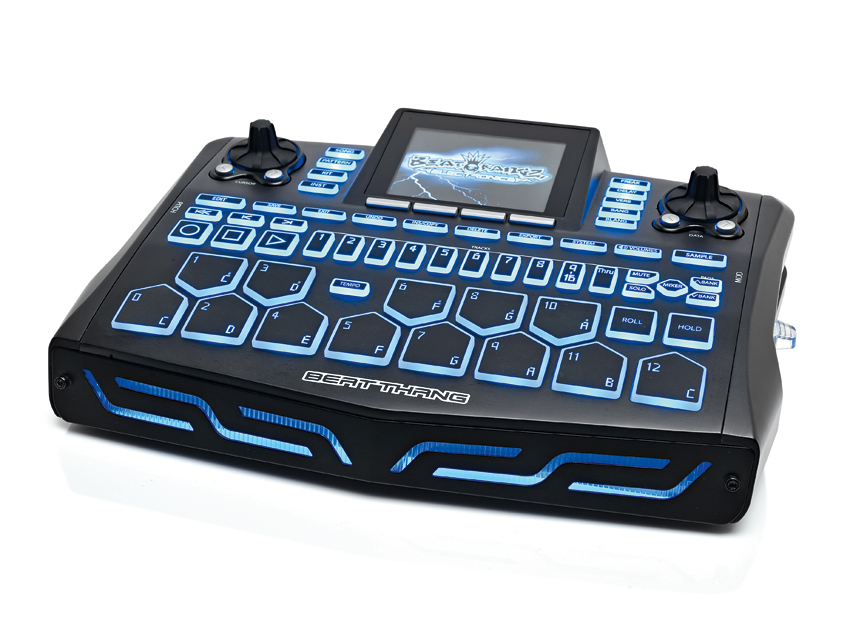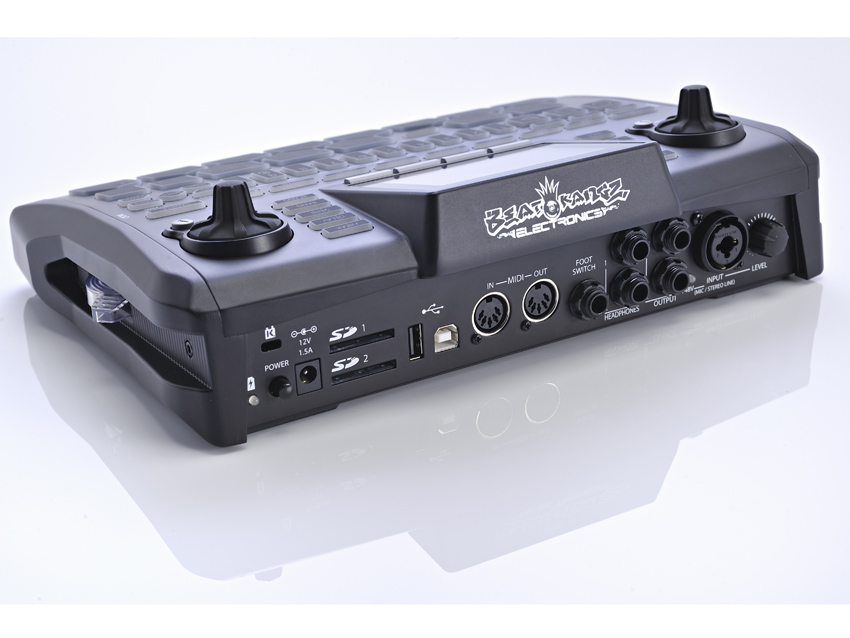MusicRadar Verdict
It's a mixed bag but we wish it well.
Pros
- +
Great build; solid beat box with a capable sequencer/sampler.
Cons
- -
Some workflow/OS issues.
MusicRadar's got your back

Beat Kangz Beat Thang

Beat Kangz Beat Thang
Ever since the Beat Thang was first announced back in 2007, there has been a lot of speculative chatter about it on forums, mainly due to its over-hyped marketing campaign.
As a result, many thought is was just 'vapourware'. Thankfully, the Beat Thang hardware is very much real. And it's built like a tank!
"Sound-wise, the onboard kits and instruments are geared towards hip-hop production and there are some great patterns onboard."
The unit is compact yet heavy and made from black steel with tough rubber buttons, side-mounted pitch and mod wheels (though the mod wheel can't currently be assigned) and a 3.5" colour LCD screen. The blue backlighting is over the top but very practical for on stage with the 'Blang' button controlling its level. No joke.
Meanwhile the built-in rechargeable Lithium-Ion battery (which can give the Beat Thang up to six hours of use without mains power) means it can be used anywhere. The Akai MPC500 is the only other similar beat box/sampler to offer battery power.
As far as the Beat Thang's user interface goes, it's a mixed bag. The fixed angle colour LCD screen is easy to read but there's no brightness control and the arrow-shaped pads (which are laid out in a piano-style octave and remind us of the Ensoniq ASR-X) are very responsive and register even the smallest tap, but they're so close together it's a little too easy to hit more than one at a time.
Strangely, there is no main front panel volume dial - all the volume options are sadly hidden under the volume menu, which disrupts workflow.
Kit editing
Now onto the main modes. A 'Kit' is a set of preset/user or sampled drum sounds mapped to the pads. You can assign up to 16 layers (sounds) to every pad, which gives you a lot of scope (plus 128-note polyphony).
The layers can be tweaked for volume, pan, pitch, velocity trigger level, one shot on/off, keyspan (note range) and more, though filter cutoff and resonance and the ADSR functions are per pad not per pad layer and filter type appears to be fixed in this mode to LPF, though can be changed on a per-track basis in pattern mode, under the 'mixer' menu.
Each pad can also have its own delay, reverb and 'freak' send level. Instrument mode is the same as Kit mode but deals with pitched instruments mapped across the pads. It's easy to sample one note and spin it out across several octaves using the keyspan feature.
It's the beat
Sound-wise, the onboard kits and instruments are geared towards hip-hop production and there are some great patterns onboard. There's a good range of dirty/processed and clean kicks, snares hats, toms and other percussive sounds (over 3,000 individual hits) though on the whole the quality of the drums is better than the onboard instruments which often sound cheap and over processed. Many suffer from clicky sample end points too.
There are some nice strings, basses and hits onboard though and the signal path is very quiet, meaning that if you load it up with your own kits and sounds they sound great when blasted back. Samples can be 16 or 24-bit and patterns can be exported to your DAW as audio using the 'export' function.
Pattern mode is the main beat creation mode and there are the usual transport controls plus eight track buttons with a 9/16 button that turns these buttons into track 9-16 selectors.
You can access up to eight banks of 13 sounds from the bank buttons here too, enabling you to access a vast range of sounds, especially if you have an external hard drive, USB flash drive or SD card(s) connected with your sounds on. Note that the Beat Thang offers USB bus power too.
Sequencer
Creating a new pattern is simple enough. Select one, set the number of bars and time signature and off you go. Each track can have its own loop length and you also change the time signature on the fly, to twist things up.
Swing can be set on a per-pattern, non-destructive basis from 0 to 100%, while quantise values can be set from off to 1/64 note. One criticism here though is that the click sound can't be changed and it often gets lost when you are recording even when the volume is maxed.
I'm glad to say the sequencer feels solid and has a nice swagger/bounce that all beat heads will dig. It also has a unique variable PPQ feature for getting a more accurate or sloppy feel, while the continuously variable swing percentage is less restrictive than the set percentage values on an MPC.
Last but not least, there are roll and hold functions. Roll is like the MPC's note repeat (and dependent on the quantise value), while 'hold' loops any sound continuously. The biggest downside here is that there is no step edit mode, though we're told this is coming. Right now as it stands, detailed event-level editing of data within a pattern is non-existent.
Song Mode facilitates pattern chaining to form song structures - something familiar to most MPC users - and it's very simple in operation and works well. Simply add a pattern to the list and tell the Beat Thang to loop it for as many bars as you wish.
Sampling
While the presets on offer are obviously designed to entice young urban producers, it's the sampling side that makes the Beat Thang into a versatile production tool.
There's 256MB of RAM standard and sampling is simple, though if you want to do stereo sampling you'll need a stereo lead, as there are no separate left and right inputs on the back.
To sample, press the sample button, create a new sample preset, set the input level, record arm and press play to start sampling. You can then save the sample and process it using normalisation, trim, reverse, time stretch, pitch-shifting or automatically slice the sample into pieces using 'Autochop' then map the pieces onto the pads.
This all works pretty smoothly and the time stretch and pitch-shift algorithms sound good. Although resampling is listed on the specs, it doesn't appear as a menu option currently.
Effects tricks
FX-wise, there are four main types onboard, which are built on open source code so third parties could eventually make effects for the Beat Thang. The effects are a little mediocre and disappointingly, switching them into the signal path often causes clicks.
The 'freak' button deals with modulation effects such as flangers, phasers and amp emulations (the tube amp particularly sounds great) plus low-pass, band-pass, high-pass, low-shelf, high-shelf and notch filters. There are also several half-decent reverbs and delays onboard and a multi-band limiter/EQ available under the 'Bang' button for basic 'mastering'.
Here's the Thang
The Beat Thang does the job and can sound great particularly when using your own samples but little niggles make it frustrating. For starters it takes 40 seconds to start up, plus it can take 10 seconds to load a new kit or pattern.
We also found ourselves having to use the exit button a lot when we simply wanted to change from one mode to another and I sometimes encountered hanging notes when changing banks.
It's also frustrating that you can't quickly go through previewing/loading sounds with the data buttons. Instead you have to turn the data dial, scroll through the list, press the data wheel and then select a new sound.
There's also no screen notification to reassure that things have saved. However, a software update would fix most of these gripes.
Besides the niggles, big features such as the ability to lock the Beat Thang to MIDI Clock or MTC (either as a slave or master) are missing, so it currently doesn't integrate well with DAWs, except as a basic MIDI pad controller to control the Beat Thang 'Virtual' software. Again we can only speculate that a raft of fixes is on the way.
Right now, though, Beat Thang doesn't offer enough deeper features, high quality workhorse sounds, or slick enough workflow to make it a must-buy. Yes, the sequencer is solid, build quality is great and the sampling works well, but for £799 RRP it needs to be better.
It does have the potential to be a lot more essential, however - plus the fact that it's built on a Linux-based OS with Open Source FX plug-ins means that the code/OS can potentially be customised by the Kangz and/or third party developers, making it a far more exciting machine than closed-up rivals.
“I called out to Mutt and said, ‘How about this?’... It was a complete fluke": How Def Leppard created a rock anthem - with a little bit of divine intervention
Baby Audio's Smooth Operator spectral balancing plugin goes pro
"It was ugly, like watching a divorce between four people. After a while, I had to get out": Beatles engineer Geoff Emerick on the recording of Abbey Road, track-by-track









